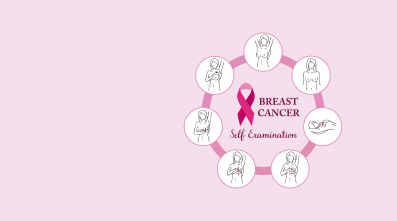Breast cancer is treatable. An early diagnosis adds to the effectiveness of the treatment. Breast self-examination is a simple yet effective way of catching breast cancer early. Even though the self-exam is not enough to determine if you have the disease; it can help when used in combination with other screening methods.
Here’s how to carry out a breast self-examination effectively.
You should carry out the self-examination after 5-6 days of the onset of your periods when the breast is not tender and sore. Follow these five breast self-examination steps:
Here’s how to carry out a breast self-examination effectively.
You should carry out the self-examination after 5-6 days of the onset of your periods when the breast is not tender and sore. Follow these five breast self-examination steps:
Step 1: Observe with elbows forward
Stand before a mirror with your arms on your hips and shoulders straight.
In this straight posture, observe the size and shape of your breasts and colour and position of your nipples.
Now, look for the following conditions while observing:
- Uneven shape or swelling of the breast
- Redness, rash, scaly skin or nipples
- Soreness
- Dimpling, puckering or bulging of the skin
- If the nipples have become inverted instead of protruding
- Visible lumps
If any of the above conditions are apparent, consult your doctor as early as possible.
Step 2: Observe with arms elevated
Raise your arms and observe your breast and the surrounding region.
Look for the same signs as mentioned above.
Step 3: Observe for discharge
Note if there is any fluid discharge from either of the nipples or both. The discharge can be watery, yellowish, milky or bloody. The presence of any kind of discharge should be brought to your doctor’s attention.
Step 4: Touch and Pressure test
This step involves lying down and then feeling your breasts. For this, lie down and prop your left hand behind your head, and feel your left breast with the right hand. Similarly, prop your right hand behind your head and feel your right breast with the left hand.
Straighten your index, middle and ring fingers together and use it to feel around the breast. With medium to light pressure and smooth touch, move your fingers in a circular motion around the breast. Make sure that you cover the whole breast while moving in circles.
Apply varying pressures for examining different regions of tissues - light pressure for feeling the skin and immediate underneath tissues; medium pressure for feeling the tissues in the middle of the breast; frim pressure for tissues at the back to the ribcage. Ensure that you have examined all these layers of tissues.
Now move your fingers vertically on your breast and surrounding region to look for underlying abnormalities.
Use similar motions with firm pressure to cover regions of the collarbone, upper abdomen beneath the breasts, armpit and cleavage.

Note any lump or underlying abnormality and inform your doctor about the same.
Step 5: Examination in wet skin
You can feel the abnormalities easily when the skin is wet and slippery. The last step involves feeling your breasts while standing or sitting. You can carry out this procedure in the shower. Raise your left arm and feel your left breast with the right hand and right breast with left arm when the right arm is raised. Also, feel your breasts with your arm by your side. Use the same motions as described in Step 4 for examining your breast.
Carry out the breast self-examination procedure once a month. If you notice any abnormality or unusual change that concerns you, contact your doctor for further check-ups.
Apart from conducting breast cancer self-exam regularly for effective treatment, it also helps to be prepared well in advance. Cancer insurance can help you in the testing times by aiding you financially. A cancer insurance plan will cover the medical expenses from the diagnosis stage right to the recuperation. It comes with low premiums, full coverage and premium waivers when diagnosed with cancer. This plan can help relieve your family of financial predicaments while ensuring your efficient treatment and well-being if you are diagnosed with cancer.


 5 Minute
|
5 Minute
|

 5 Minute |
5 Minute |